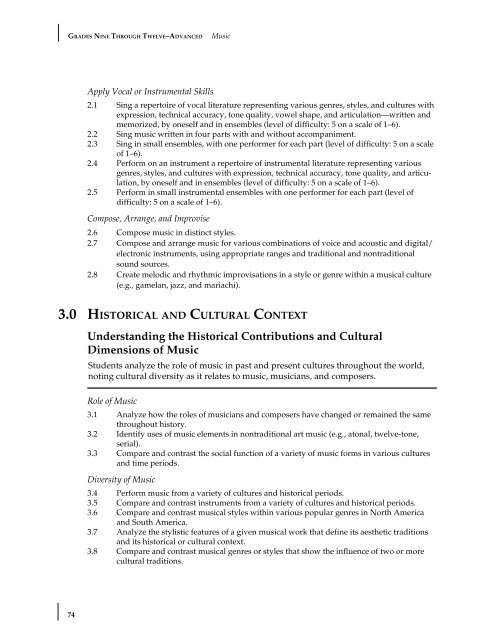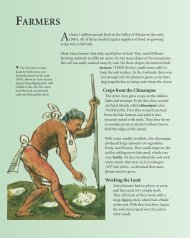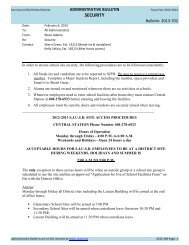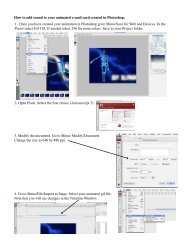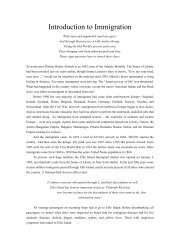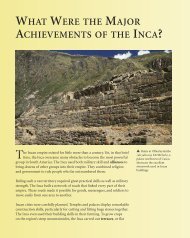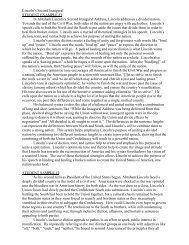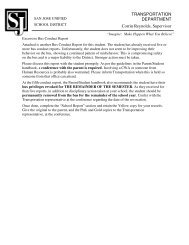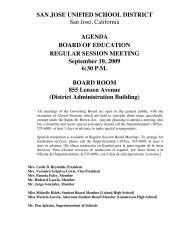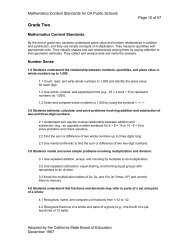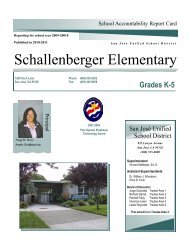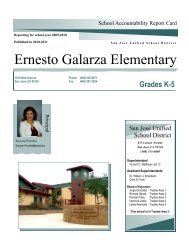Visual and Performing Arts Content Standards - California ...
Visual and Performing Arts Content Standards - California ...
Visual and Performing Arts Content Standards - California ...
You also want an ePaper? Increase the reach of your titles
YUMPU automatically turns print PDFs into web optimized ePapers that Google loves.
GRADES NINE THROUGH TWELVE–ADVANCED Music<br />
Apply Vocal or Instrumental Skills<br />
2.1 Sing a repertoire of vocal literature representing various genres, styles, <strong>and</strong> cultures with<br />
expression, technical accuracy, tone quality, vowel shape, <strong>and</strong> articulation—written <strong>and</strong><br />
memorized, by oneself <strong>and</strong> in ensembles (level of difficulty: 5 on a scale of 1–6).<br />
2.2 Sing music written in four parts with <strong>and</strong> without accompaniment.<br />
2.3 Sing in small ensembles, with one performer for each part (level of difficulty: 5 on a scale<br />
of 1–6).<br />
2.4 Perform on an instrument a repertoire of instrumental literature representing various<br />
genres, styles, <strong>and</strong> cultures with expression, technical accuracy, tone quality, <strong>and</strong> articulation,<br />
by oneself <strong>and</strong> in ensembles (level of difficulty: 5 on a scale of 1–6).<br />
2.5 Perform in small instrumental ensembles with one performer for each part (level of<br />
difficulty: 5 on a scale of 1–6).<br />
Compose, Arrange, <strong>and</strong> Improvise<br />
2.6 Compose music in distinct styles.<br />
2.7 Compose <strong>and</strong> arrange music for various combinations of voice <strong>and</strong> acoustic <strong>and</strong> digital/<br />
electronic instruments, using appropriate ranges <strong>and</strong> traditional <strong>and</strong> nontraditional<br />
sound sources.<br />
2.8 Create melodic <strong>and</strong> rhythmic improvisations in a style or genre within a musical culture<br />
(e.g., gamelan, jazz, <strong>and</strong> mariachi).<br />
3.0 HISTORICAL AND CULTURAL CONTEXT<br />
74<br />
Underst<strong>and</strong>ing the Historical Contributions <strong>and</strong> Cultural<br />
Dimensions of Music<br />
Students analyze the role of music in past <strong>and</strong> present cultures throughout the world,<br />
noting cultural diversity as it relates to music, musicians, <strong>and</strong> composers.<br />
Role of Music<br />
3.1 Analyze how the roles of musicians <strong>and</strong> composers have changed or remained the same<br />
throughout history.<br />
3.2 Identify uses of music elements in nontraditional art music (e.g., atonal, twelve-tone,<br />
serial).<br />
3.3 Compare <strong>and</strong> contrast the social function of a variety of music forms in various cultures<br />
<strong>and</strong> time periods.<br />
Diversity of Music<br />
3.4 Perform music from a variety of cultures <strong>and</strong> historical periods.<br />
3.5 Compare <strong>and</strong> contrast instruments from a variety of cultures <strong>and</strong> historical periods.<br />
3.6 Compare <strong>and</strong> contrast musical styles within various popular genres in North America<br />
<strong>and</strong> South America.<br />
3.7 Analyze the stylistic features of a given musical work that define its aesthetic traditions<br />
<strong>and</strong> its historical or cultural context.<br />
3.8 Compare <strong>and</strong> contrast musical genres or styles that show the influence of two or more<br />
cultural traditions.


